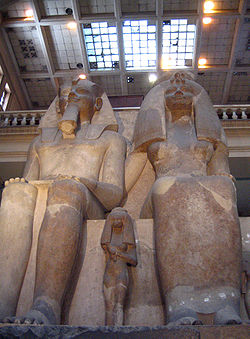Biography
Henuttaneb is shown on a colossal statue from Medinet Habu. [2] This huge seven-metre-high (23 ft) sculpture shows Amenhotep III and Tiye seated side by side, "with three of their daughters standing in front of the throne--Henuttaneb, the largest and best preserved, in the centre; Nebetah on the right; and another, whose name is destroyed, on the left". [3] She also appears in the temple at Soleb and on a carnelian plaque (with her sister Iset, before their parents). Her name appears on three faience fragments. [4]
It is unclear whether Henuttaneb was elevated to the rank of queen like Sitamun and Iset. She is nowhere mentioned as King's Wife, but on the aforementioned carnelian plaque her name is enclosed in a cartouche, a privilege which only kings and their wives were entitled to.
After the death of her father, she is not mentioned again.
This page is based on this
Wikipedia article Text is available under the
CC BY-SA 4.0 license; additional terms may apply.
Images, videos and audio are available under their respective licenses.

